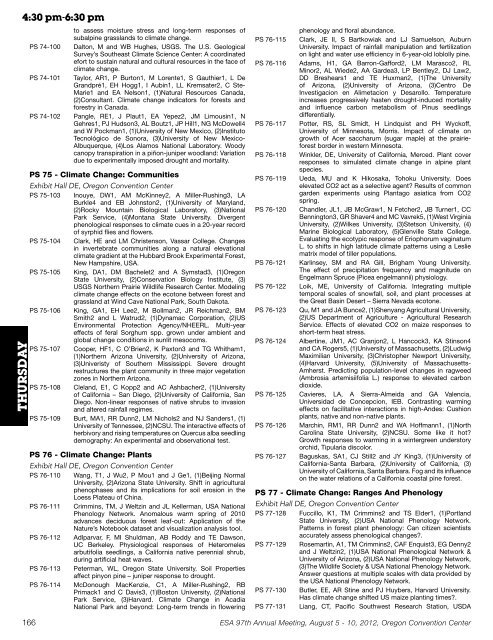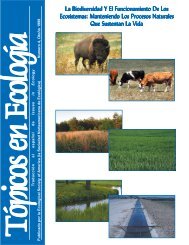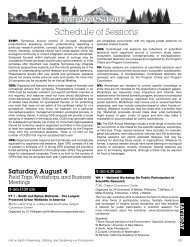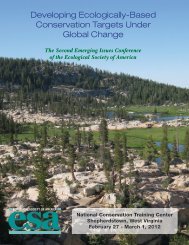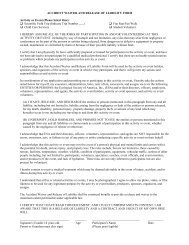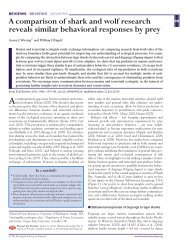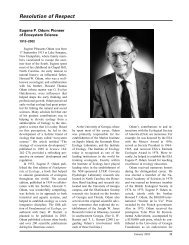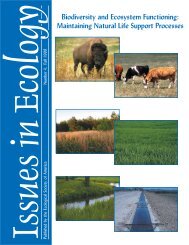Printed Program (PDF) - Ecological Society of America
Printed Program (PDF) - Ecological Society of America
Printed Program (PDF) - Ecological Society of America
Create successful ePaper yourself
Turn your PDF publications into a flip-book with our unique Google optimized e-Paper software.
THURSDAY<br />
4:30 pm-6:30 pm<br />
to assess moisture stress and long-term responses <strong>of</strong><br />
subalpine grasslands to climate change.<br />
PS 74-100 Dalton, M and WB Hughes, USGS. The U.S. Geological<br />
Survey’s Southeast Climate Science Center: A coordinated<br />
efort to sustain natural and cultural resources in the face <strong>of</strong><br />
climate change.<br />
PS 74-101 Taylor, AR1, P Burton1, M Lorente1, S Gauthier1, L De<br />
Grandpré1, EH Hogg1, I Aubin1, LL Kremsater2, C Ste-<br />
Marie1 and EA Nelson1, (1)Natural Resources Canada,<br />
(2)Consultant. Climate change indicators for forests and<br />
forestry in Canada.<br />
PS 74-102 Pangle, RE1, J Plaut1, EA Yepez2, JM Limousin1, N<br />
Gehres1, PJ Hudson3, AL Boutz1, JP Hill1, NG McDowell4<br />
and W Pockman1, (1)University <strong>of</strong> New Mexico, (2)Instituto<br />
Tecnológico de Sonora, (3)University <strong>of</strong> New Mexico-<br />
Albuquerque, (4)Los Alamos National Laboratory. Woody<br />
canopy transpiration in a piñon-juniper woodland: Variation<br />
due to experimentally imposed drought and mortality.<br />
PS 75 - Climate Change: Communities<br />
Exhibit Hall DE, Oregon Convention Center<br />
PS 75-103 Inouye, DW1, AM McKinney2, A Miller-Rushing3, LA<br />
Burkle4 and EB Johnston2, (1)University <strong>of</strong> Maryland,<br />
(2)Rocky Mountain Biological Laboratory, (3)National<br />
Park Service, (4)Montana State University. Divergent<br />
phenological responses to climate cues in a 20-year record<br />
<strong>of</strong> syrphid flies and flowers.<br />
PS 75-104 Clark, HE and LM Christenson, Vassar College. Changes<br />
in invertebrate communities along a natural elevational<br />
climate gradient at the Hubbard Brook Experimental Forest,<br />
New Hampshire, USA.<br />
PS 75-105 King, DA1, DM Bachelet2 and A Symstad3, (1)Oregon<br />
State University, (2)Conservation Biology Institute, (3)<br />
USGS Northern Prairie Wildlife Research Center. Modeling<br />
climate change effects on the ecotone between forest and<br />
grassland at Wind Cave National Park, South Dakota.<br />
PS 75-106 King, GA1, EH Lee2, M Bollman2, JR Reichman2, BM<br />
Smith2 and L Watrud2, (1)Dynamac Corporation, (2)US<br />
Environmental Protection Agency/NHEERL. Multi-year<br />
effects <strong>of</strong> feral Sorghum spp. grown under ambient and<br />
global change conditions in sunlit mesocoms.<br />
PS 75-107 Cooper, HF1, C O’Brien2, K Paxton3 and TG Whitham1,<br />
(1)Northern Arizona University, (2)University <strong>of</strong> Arizona,<br />
(3)Univeristy <strong>of</strong> Southern Mississippi. Severe drought<br />
restructures the plant community in three major vegetation<br />
zones in Northern Arizona.<br />
PS 75-108 Cleland, E1, C Kopp2 and AC Ashbacher2, (1)University<br />
<strong>of</strong> California – San Diego, (2)University <strong>of</strong> California, San<br />
Diego. Non-linear responses <strong>of</strong> native shrubs to invasion<br />
and altered rainfall regimes.<br />
PS 75-109 Burt, MA1, RR Dunn2, LM Nichols2 and NJ Sanders1, (1)<br />
University <strong>of</strong> Tennessee, (2)NCSU. The interactive effects <strong>of</strong><br />
herbivory and rising temperatures on Quercus alba seedling<br />
demography: An experimental and observational test.<br />
PS 76 - Climate Change: Plants<br />
Exhibit Hall DE, Oregon Convention Center<br />
PS 76-110 Wang, T1, J Wu2, P Mou1 and J Ge1, (1)Beijing Normal<br />
University, (2)Arizona State University. Shift in agricultural<br />
phenophases and its implications for soil erosion in the<br />
Loess Plateau <strong>of</strong> China.<br />
PS 76-111 Crimmins, TM, J Weltzin and JL Kellerman, USA National<br />
Phenology Network. Anomalous warm spring <strong>of</strong> 2010<br />
advances deciduous forest leaf-out: Application <strong>of</strong> the<br />
Nature’s Notebook dataset and visualization analysis tool.<br />
PS 76-112 Adlparvar, F, MI Shuldman, AB Roddy and TE Dawson,<br />
UC Berkeley. Physiological responses <strong>of</strong> Heteromeles<br />
arbutifolia seedlings, a California native perennial shrub,<br />
during artificial heat waves.<br />
PS 76-113 Peterman, WL, Oregon State University. Soil Properties<br />
affect pinyon pine – juniper response to drought.<br />
PS 76-114 McDonough MacKenzie, C1, A Miller-Rushing2, RB<br />
Primack1 and C Davis3, (1)Boston University, (2)National<br />
Park Service, (3)Harvard. Climate Change in Acadia<br />
National Park and beyond: Long-term trends in flowering<br />
phenology and floral abundance.<br />
PS 76-115 Clark, JE II, S Bartkowiak and LJ Samuelson, Auburn<br />
University. Impact <strong>of</strong> rainfall manipulation and fertilization<br />
on light and water use efficiency in 6-year-old loblolly pine.<br />
PS 76-116 Adams, H1, GA Barron-Gafford2, LM Marasco2, RL<br />
Minor2, AL Wiede2, AA Gardea3, LP Bentley2, DJ Law2,<br />
DD Breshears1 and TE Huxman2, (1)The University<br />
<strong>of</strong> Arizona, (2)University <strong>of</strong> Arizona, (3)Centro De<br />
Investigacion en Alimetacion y Desarollo. Temperature<br />
increases progressively hasten drought-induced mortality<br />
and influence carbon metabolism <strong>of</strong> Pinus seedlings<br />
differentially.<br />
PS 76-117 Potter, RS, SL Smidt, H Lindquist and PH Wyck<strong>of</strong>f,<br />
University <strong>of</strong> Minnesota, Morris. Impact <strong>of</strong> climate on<br />
growth <strong>of</strong> Acer saccharum (sugar maple) at the prairieforest<br />
border in western Minnesota.<br />
PS 76-118 Winkler, DE, University <strong>of</strong> California, Merced. Plant cover<br />
responses to simulated climate change in alpine plant<br />
species.<br />
PS 76-119 Ueda, MU and K Hikosaka, Tohoku University. Does<br />
elevated CO2 act as a selective agent? Results <strong>of</strong> common<br />
garden experiments using Plantago asiatica from CO2<br />
spring.<br />
PS 76-120 Chandler, JL1, JB McGraw1, N Fetcher2, JB Turner1, CC<br />
Bennington3, GR Shaver4 and MC Vavrek5, (1)West Virginia<br />
University, (2)Wilkes University, (3)Stetson University, (4)<br />
Marine Biological Laboratory, (5)Glenville State College.<br />
Evaluating the ecotypic response <strong>of</strong> Eriophorum vaginatum<br />
L. to shifts in high latitude climate patterns using a Leslie<br />
matrix model <strong>of</strong> tiller populations.<br />
PS 76-121 Karlinsey, SM and RA Gill, Brigham Young University.<br />
The effect <strong>of</strong> precipitation frequency and magnitude on<br />
Engelmann Spruce (Picea engelmannii) physiology.<br />
PS 76-122 Loik, ME, University <strong>of</strong> California. Integrating multiple<br />
temporal scales <strong>of</strong> snowfall, soil, and plant processes at<br />
the Great Basin Desert – Sierra Nevada ecotone.<br />
PS 76-123 Qu, M1 and JA Bunce2, (1)Shenyang Agricultural University,<br />
(2)US Department <strong>of</strong> Agriculture - Agricultural Research<br />
Service. Effects <strong>of</strong> elevated CO2 on maize responses to<br />
short-term heat stress.<br />
PS 76-124 Albertine, JM1, AC Granjon2, L Hancock3, KA Stinson4<br />
and CA Rogers5, (1)University <strong>of</strong> Massachusetts, (2)Ludwig<br />
Maximilian University, (3)Christopher Newport University,<br />
(4)Harvard University, (5)University <strong>of</strong> Massachusetts-<br />
Amherst. Predicting population-level changes in ragweed<br />
(Ambrosia artemisiifolia L.) response to elevated carbon<br />
dioxide.<br />
PS 76-125 Cavieres, LA, A Sierra-Almeida and GA Valencia,<br />
Universidad de Concepcion, IEB. Contrasting warming<br />
effects on facilitative interactions in high-Andes: Cushion<br />
plants, native and non-native plants.<br />
PS 76-126 Marchin, RM1, RR Dunn2 and WA H<strong>of</strong>fmann1, (1)North<br />
Carolina State University, (2)NCSU. Some like it hot?<br />
Growth responses to warming in a wintergreen understory<br />
orchid, Tipularia discolor.<br />
PS 76-127 Baguskas, SA1, CJ Still2 and JY King3, (1)University <strong>of</strong><br />
California-Santa Barbara, (2)University <strong>of</strong> California, (3)<br />
University <strong>of</strong> California, Santa Barbara. Fog and its influence<br />
on the water relations <strong>of</strong> a California coastal pine forest.<br />
PS 77 - Climate Change: Ranges And Phenology<br />
Exhibit Hall DE, Oregon Convention Center<br />
PS 77-128 Fuccillo, K1, TM Crimmins2 and TS Elder1, (1)Portland<br />
State University, (2)USA National Phenology Network.<br />
Patterns in forest plant phenology: Can citizen scientists<br />
accurately assess phenological changes?.<br />
PS 77-129 Rosemartin, A1, TM Crimmins2, CAF Enquist3, EG Denny2<br />
and J Weltzin2, (1)USA National Phenological Network &<br />
University <strong>of</strong> Arizona, (2)USA National Phenology Network,<br />
(3)The Wildlife <strong>Society</strong> & USA National Phenology Network.<br />
Answer questions at multiple scales with data provided by<br />
the USA National Phenology Network.<br />
PS 77-130 Butler, EE, AR Stine and PJ Huybers, Harvard University.<br />
Has climate change shifted US maize planting times?.<br />
PS 77-131 Liang, CT, Pacific Southwest Research Station, USDA<br />
166 ESA 97th Annual Meeting, August 5 - 10, 2012, Oregon Convention Center


